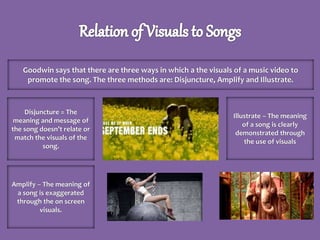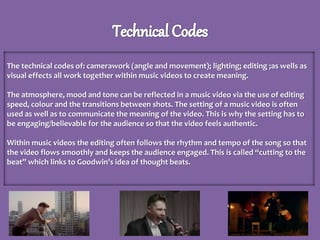Goodwin Theory
- 2. • Published book “Dancing in the Distraction Factory” in 1992 • In this book he made many notable observations about music videos
- 3. According to Goodwin music videos will often contain genre characteristics through iconography. This is done to set up expectations and to communicate meanings. The images above are from two different genres, country and rap. The rap images contain clear rap characteristics such as the heavy bling and tank tops, another convention shown is the top left image in which Wiz is rapping to the camera which is using a low angle shot. The images on the right are from a country video and feature the conventions of showing the band (or artist) performing the song and also features many close ups of the instruments being played.
- 4. Goodwin said that the structure and tempo of the song are represented visually throughout music videos. This is usually done through pace of editing and through cutting the video to the beat. The artists voice must also represent the artists voice, brand and identity. Its said that an artists voice can be used as a trademark and in most videos the star image will happen with the artist on screen/singing.
- 5. In his book, Goodwin says that music videos have two main purposes. To tell the story and to advertise the song and artist. Goodwin says that a key thing that music videos need to have is repeatability. They need to be something that an audience will want to watch multiple times without getting bored. According to Goodwin a music video in which the artist acts as both the narrator and a participant within the videos are the most authentic and successful. Lip-syncing and miming are the key parts of a music video. The audience needs to believe these are real. Without this belief in the artists performance a music video cannot be truly successful.
- 6. Goodwin says that there are three ways in which a the visuals of a music video to promote the song. The three methods are: Disjuncture, Amplify and Illustrate. Disjuncture = The meaning and message of the song doesn’t relate or match the visuals of the song. Amplify – The meaning of a song is exaggerated through the on screen visuals. Illustrate – The meaning of a song is clearly demonstrated through the use of visuals
- 7. To do this music videos often contain a proliferation of money shots. These are shots of the artist that emphasise their image/style to make them more appealing and memorable for the audience. A music videos main purpose is to promote the artist/band. The music video is meant to increase the artists reputation and also the sales of their music. During the creation and production of a video the artist is usually made to be the focal point of the video so that they are promoted effectively.
- 8. Voyeurism is a feature of many music videos across a number of genres. It is especially present in the representation of female artists/characters within music videos. It is also present within terms of “looking” within the world of the video such as: - Screens within the world - Eyes - Mirrors - Cameras - Close-ups
- 9. The technical codes of: camerawork (angle and movement); lighting; editing ;as wells as visual effects all work together within music videos to create meaning. The atmosphere, mood and tone can be reflected in a music video via the use of editing speed, colour and the transitions between shots. The setting of a music video is often used as well as to communicate the meaning of the video. This is why the setting has to be engaging/believable for the audience so that the video feels authentic. Within music videos the editing often follows the rhythm and tempo of the song so that the video flows smoothly and keeps the audience engaged. This is called “cutting to the beat” which links to Goodwin's idea of thought beats.
- 10. Intertextuality often features within music videos. There are often references to videos, films, TV texts and/or references to pop culture. The reason for this is to engage the audience as when the audience recognises some intertextuality they enjoy the video more.









